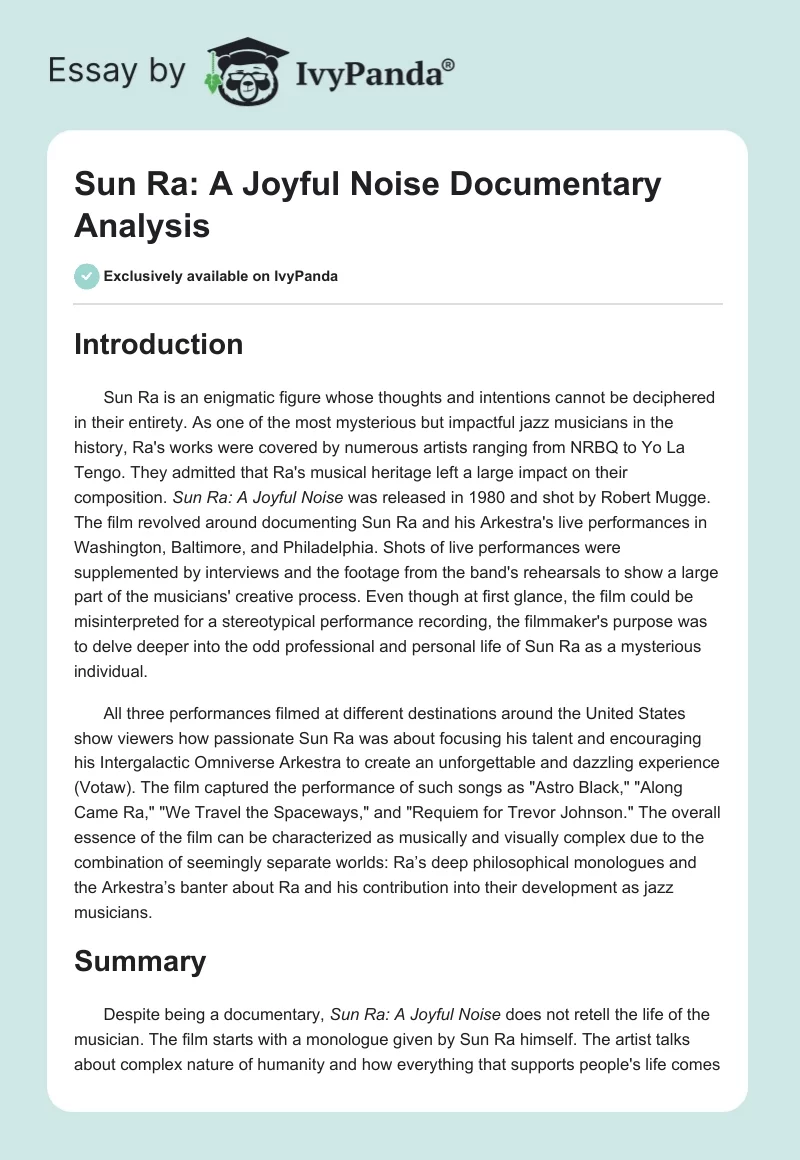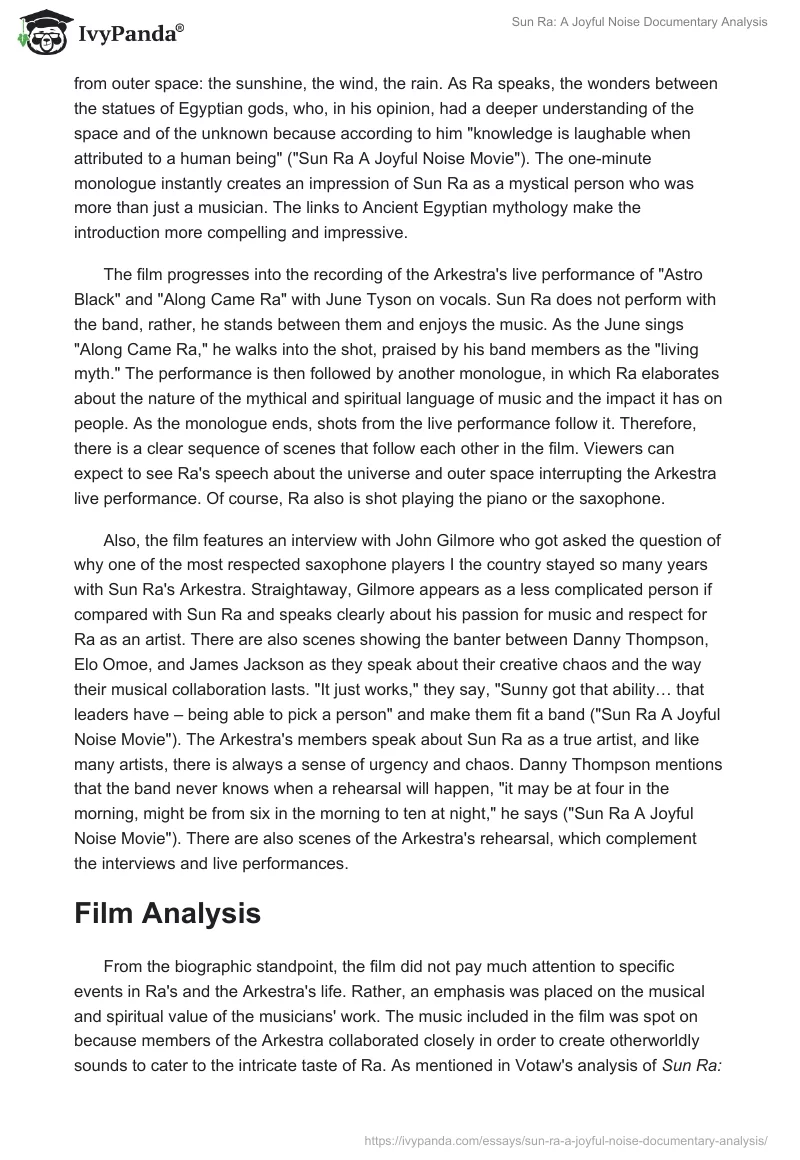Introduction
Sun Ra is an enigmatic figure whose thoughts and intentions cannot be deciphered in their entirety. As one of the most mysterious but impactful jazz musicians in the history, Ra’s works were covered by numerous artists ranging from NRBQ to Yo La Tengo. They admitted that Ra’s musical heritage left a large impact on their composition. Sun Ra: A Joyful Noise was released in 1980 and shot by Robert Mugge.
The film revolved around documenting Sun Ra and his Arkestra’s live performances in Washington, Baltimore, and Philadelphia. Shots of live performances were supplemented by interviews and the footage from the band’s rehearsals to show a large part of the musicians’ creative process. Even though at first glance, the film could be misinterpreted for a stereotypical performance recording, the filmmaker’s purpose was to delve deeper into the odd professional and personal life of Sun Ra as a mysterious individual.
All three performances filmed at different destinations around the United States show viewers how passionate Sun Ra was about focusing his talent and encouraging his Intergalactic Omniverse Arkestra to create an unforgettable and dazzling experience (Votaw). The film captured the performance of such songs as “Astro Black,” “Along Came Ra,” “We Travel the Spaceways,” and “Requiem for Trevor Johnson.” The overall essence of the film can be characterized as musically and visually complex due to the combination of seemingly separate worlds: Ra’s deep philosophical monologues and the Arkestra’s banter about Ra and his contribution into their development as jazz musicians.
Summary
Despite being a documentary, Sun Ra: A Joyful Noise does not retell the life of the musician. The film starts with a monologue given by Sun Ra himself. The artist talks about complex nature of humanity and how everything that supports people’s life comes from outer space: the sunshine, the wind, the rain. As Ra speaks, the wonders between the statues of Egyptian gods, who, in his opinion, had a deeper understanding of the space and of the unknown because according to him “knowledge is laughable when attributed to a human being” (“Sun Ra A Joyful Noise Movie”). The one-minute monologue instantly creates an impression of Sun Ra as a mystical person who was more than just a musician. The links to Ancient Egyptian mythology make the introduction more compelling and impressive.
The film progresses into the recording of the Arkestra’s live performance of “Astro Black” and “Along Came Ra” with June Tyson on vocals. Sun Ra does not perform with the band, rather, he stands between them and enjoys the music. As the June sings “Along Came Ra,” he walks into the shot, praised by his band members as the “living myth.” The performance is then followed by another monologue, in which Ra elaborates about the nature of the mythical and spiritual language of music and the impact it has on people. As the monologue ends, shots from the live performance follow it. Therefore, there is a clear sequence of scenes that follow each other in the film. Viewers can expect to see Ra’s speech about the universe and outer space interrupting the Arkestra live performance. Of course, Ra also is shot playing the piano or the saxophone.
Also, the film features an interview with John Gilmore who got asked the question of why one of the most respected saxophone players I the country stayed so many years with Sun Ra’s Arkestra. Straightaway, Gilmore appears as a less complicated person if compared with Sun Ra and speaks clearly about his passion for music and respect for Ra as an artist. There are also scenes showing the banter between Danny Thompson, Elo Omoe, and James Jackson as they speak about their creative chaos and the way their musical collaboration lasts. “It just works,” they say, “Sunny got that ability… that leaders have – being able to pick a person” and make them fit a band (“Sun Ra A Joyful Noise Movie”).
The Arkestra’s members speak about Sun Ra as a true artist, and like many artists, there is always a sense of urgency and chaos. Danny Thompson mentions that the band never knows when a rehearsal will happen, “it may be at four in the morning, might be from six in the morning to ten at night,” he says (“Sun Ra A Joyful Noise Movie”). There are also scenes of the Arkestra’s rehearsal, which complement the interviews and live performances.
Film Analysis
From the biographic standpoint, the film did not pay much attention to specific events in Ra’s and Arkestra’s life. Rather, an emphasis was placed on the musical and spiritual value of the musicians’ work. The music included in the film was spot on because members of the Arkestra collaborated closely in order to create otherworldly sounds to cater to the intricate taste of Ra. As mentioned in Votaw’s analysis of Sun Ra: A Joyful Noise, “the sound was large, sometimes off-kilter and always oddly inviting.” Given the charismatic and enigmatic presence of the Arkestra’s front singer, the live performances feel much more satisfying than listening to the recordings.
Ra’s contribution to jazz music was treated reverentially by the filmmakers of A Joyful Noise, which is similar to the approach John Szwed took in his book Space is the Place: The Lives and Times of Sun Ra. Robert Mugge’s involvement with Sun Ra, the filmmaker was successful in conducting numerous interviews with the musicians to offer viewers a closer look at who Ra was and what was his attitude towards the craft. The reverential tone of the film is also seen from a certain distance between Sun Ra and the interviewer. By the end of the film, it is doubted whether viewers could feel a personal connection to the musician. However, the mystique of Sun Ra as an artist became clearer because of his elaboration on poetry, philosophy, as well as a generally unconventional way of living a life.
In the shots of the interviews, Sun Ra has a full face of makeup, similar to a pharaoh. He also appears wearing a bright pink headscarf with a gold netting on top of it as well as a gold mask as if he was going to a Mardi Gras festival. His fashion was bizarre, to say the least; however, his overall appearance aligned with his inner philosophy. When being interviewed, Ra talked about everything from his youth years to the beliefs of his mysterious personal nature. Some of the comments he made about the nature of the world seemed confusing and out of place. However, the intention with which he talked about his beliefs in the mysterious and supernatural allowed the film’s viewers understand that Sun Ra had a complex character that was reflected in his music.
In the exploration of Sun Ra as an artist, it is important to compare the ways others presented and analyzed him. In Space is the Place, Szwed paid great attention to the musician’s personal life from his upbringing to the time when he interviewed Ra. The tone of the book was reverential because the author acknowledges the enigmatic persona of Sun Ra and tries to decipher his personal recollections no matter how complex and confusing they had been (Szwed 90). The book was more beneficial for getting a deeper understanding of how Ra’s personal life had affected his career as well as getting a more intimate account of it. This can be explained by the fact that Szwed had more time to study Sun Ra and edit his work to present the most compelling literature piece. Mugge, on the contrary, gave his viewers an opportunity to look beyond Ra’s contribution to music and discover the artist from the perspective of his philosophical ideas.
None of the mediums that explored Ra as a musician and as an individual was sensationalist or caricature-like in the presentation of material. Both the book and the documentary made it possible for the target audience to see that in some ways, there was a comedic side to Ra, especially when it comes to his peculiar taste in clothing or the seemingly never-ending discussions about the supernatural. Ra can be seen as a caricature of himself because there is no one else similar to him. Overall, both the book and the film had positive intentions of painting Sun Ra as a one-of-a-kind artist who did not conform to any norms or standards set by the society. As said by Mugge himself, Sun Ra was a “profound philosopher who told fables, created myths and created metaphors which he hoped people would learn from” (qtd in. “DVD Review: Robert Mugge – Sun Ra: A Joyful Noise”).
Conclusion
Sun Ra: A Joyful Noise directed by Robert Mugge captures the essence of the musician in the sequences of discursive monologues intertwined with the shots of the Arkestra’s live performances. In the film, Sun Ra never loses himself and his complex philosophy but is free to explore every topic his heart desires. The name A Joyful Noise has distinct Biblical rhetoric that connects the characteristics of Sun Ra as a mysterious persona that so many jazz musicians after Hum saw as the embodiment of genius. Apart from having a valuable talent, Sun Ra could boast of another quality inherent of preachers and cult leaders – to articulate his visions through a monologue.
From watching Sun Ra: A Joyful Noise and reading Space is the Place: The Life and Times of Sun Ra, it can be concluded that Sun Ra was not only a very talented jazz musician. He was deeply entrenched in the spiritual and transcendent aspects of his life, and this interest heavily influenced his works as a musician. Both Mugge and Szwed managed to capture Sun Ra as a person who continuously explored himself from the spiritual perspective, which was appealing to the audience. The author and the director respected Ra’s craft and painted the artist in a reverential light despite having to deal with the complexity of his persona, especially when it came to one-on-one interviews.
Works Cited
“DVD Review: Robert Mugge – Sun Ra: A Joyful Noise.” London Jazz News. 2016. Web.
“Sun Ra A Joyful Noise Movie.” Youtube, uploaded by STILL TURTLE presents MAKETURTLEISLANDGREATAGAIN. 2017. Web.
Szwed, John. Space is the Place: The Lives and Times of Sun Ra. Pantheon Books, 1997.
Votaw, Emily. “Sun Ra: A Joyful Noise and the Joy of Ra’s Mythocracy.” Pop Matters. 2016. Web.


